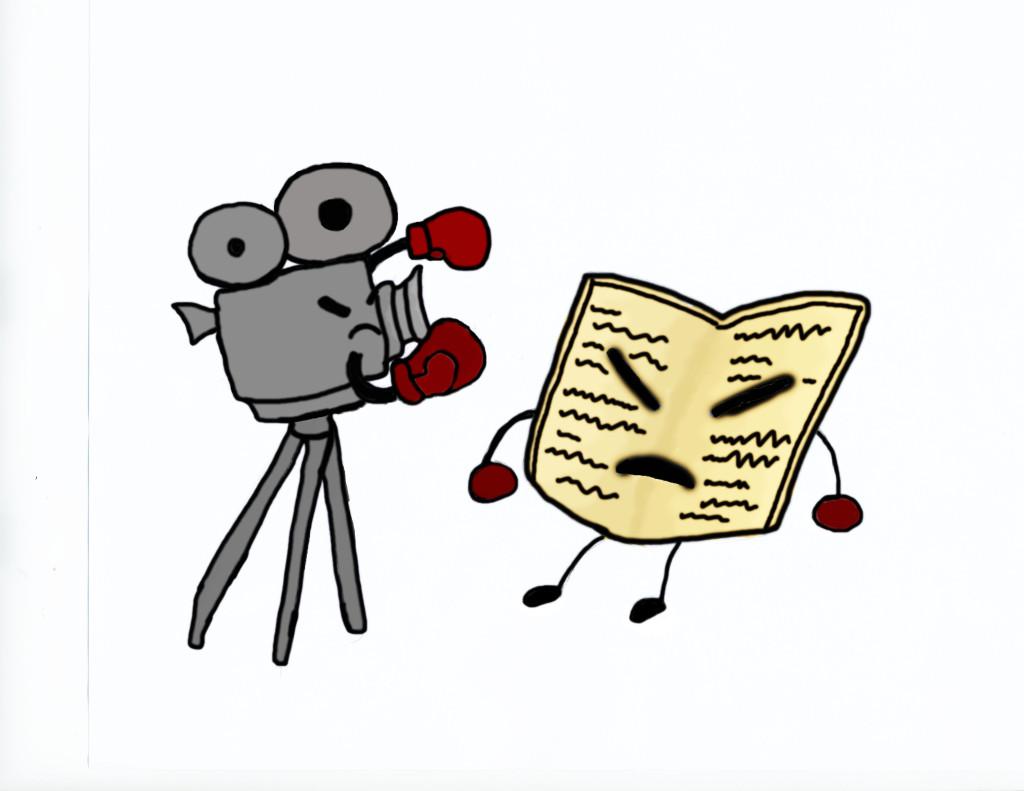Everyone has been in this situation: you head to the theaters with growing anticipation, practically drowning in merchandise from your favorite franchise. This is it; this is when you get to watch the big screen adaptation of that novel or TV show you absolutely cannot stop talking about. Two hours later, you come out of the theater with a very different attitude from the one you had going in.
“Wow,” you think out loud, “that was terrible.” Now you probably feel ridiculous in that outfit of yours.
If we all had a dime for every film that had the words “Based on…” somewhere in the credits, we’d all be millionaires. The Hunger Games, Transformers, The Avengers and Twilight are four out of what seems like four million different film adaptations, and these types of movies are still being pumped out of Hollywood like a flood.
Out of those “four million,” only a handful are actually good; all others get colossal thumbs down from critics and fans alike. How exactly does this happen, even if the source material is successful and seems like a guaranteed blockbuster?
Simply making film adaptations is like a game tug-of-war between the film studios and the masses. When one side gets too much pull, people start to put up their dukes. From the perspective of the masses, writers and directors make unnecessary or questionable subtractions from the source material and add things that only prompt the perennial “That wasn’t in the book!” or “That didn’t happen in the show!”
Surely we’re all still smarting over the fan fiction-infested scene in Harry Potter and the Deathly Hallows Part 1 where Harry and Hermoine share a rather awkward romantic moment.
In the studios’ defense, however, cuts and additions must be made in order to not only make the film version flow and stay concise, but also keep “unfamiliars” from getting lost.
“Just as important as the addition of information is the deletion of scenes,” film production teacher Donna Walker said.
Though a compromise seems tough to find in this situation, a best course of action does in fact exist. For example, if Warner Brothers wanted to churn out another Harry Potter film, they can’t exactly pull J.K. Rowling from her home in England, sit her down in front of a computer and expect her to write a film. They can, however, get a writer or two who take wizards, Unforgivable Curses and butterbeer as seriously as Rowling does.
Walker cites Peter Jackson’s second Hobbit film as a good example, pointing out a particular scene where protagonist Bilbo briefly loses the pivotal One Ring and begins to realize that the Ring is beginning to control him. Walker adds that the scene is laudable for not only adhereing to the novel, but also for exploring themes beyond the novel’s scope.
Film adaptations like Harry Potter and the Sorcerer’s Stone and Spider-Man 2 aren’t good just because one character wears something just as they did in the source material. The key to making the best adaptation possible is the one thing that everyone does when they flip through a comic book, read through the latest novel, or watch a TV episode: identify with the story and the characters.
When people connect on a personal level to a work of fiction, they begin to see past superficialities like gimmicks and see the work’s world as a real, living and breathing entity.
“I realize the point of film franchises is to make money, but I wish there could be a better balance between profit and attention to the art form,” Walker said.
Writers should embrace the source material; that is, try to understand all the nuances that make the franchise popular to begin with. Instead of focusing solely on shoving nods to the source material into the screenplay, milking every last cent out of fans or trying to be different by changing things around, studios should take a closer look at our favorite stories.
They should try to ensure that the visuals, emotion and character are true to form.
Given enough time, more studios will hopefully come to realize that while it is necessary to take some creative liberties with the stories we love, it is of the utmost importance to also abide by a principle best expressed by Billy Joel: “don’t go changin’.”
Lost in translation: Building a better film adaptation
Categories:
0
Navigate Left
-
 LifestylesCaffeine Craze
LifestylesCaffeine Craze -
 LifestylesFalling For Fall
LifestylesFalling For Fall -
 Lifestyles"KPop Demon Hunters" Review: A Golden Movie
Lifestyles"KPop Demon Hunters" Review: A Golden Movie -
 LifestylesDesk to Destination
LifestylesDesk to Destination -
 LifestylesSeverance: A Mind Splitting Masterpiece
LifestylesSeverance: A Mind Splitting Masterpiece -
 LifestylesLife of a Chess Master
LifestylesLife of a Chess Master -
 LifestylesTrouble With Texting
LifestylesTrouble With Texting -
 LifestylesCanine Counseling Connections
LifestylesCanine Counseling Connections -
 LifestylesMS Play Sparks Nostalgia
LifestylesMS Play Sparks Nostalgia -
 LifestylesMarvel's Brave New Step
LifestylesMarvel's Brave New Step
Navigate Right
About the Contributors

CHRISTIAN DANTES, STAFF WRITER
Christian Dantes is a senior and new staff writer this year. He enjoys writing, pizza, gaming and (when nobody’s around) singing along to classic rock. He is aspiring to be a screenwriter for either movies or television. He also enjoys putting in his two cents on current topics especially new and upcoming films. Contact at [email protected].

Amy Sukserm, Layout Editor
Amy Sukserm is super pumped to start her third and final year on The Voice staff as Layout Editor. Outside of journalism she is a captain on the Forensics team, enjoys playing piano, guitar, writing poetry, wearing suits, and is always ready to stick it to the man. She also is currently involved in a loving relationship with anything that appears on her plate. She really likes food. A lot.




